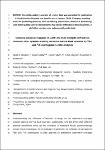Complex erosional response to uplift and rock strength contrasts in transient river systems crossing an active normal fault revealed by 10Be and 26Al cosmogenic nuclide analyses
| dc.contributor.author | Boulton, S | |
| dc.contributor.author | Rodes, A | |
| dc.contributor.author | Fabel, D | |
| dc.contributor.author | Alcicek, MC | |
| dc.contributor.author | Whittaker, A | |
| dc.date.accessioned | 2024-01-12T17:04:53Z | |
| dc.date.available | 2024-01-12T17:04:53Z | |
| dc.date.issued | 2024-02-07 | |
| dc.identifier.issn | 1096-9837 | |
| dc.identifier.issn | 1096-9837 | |
| dc.identifier.uri | https://pearl.plymouth.ac.uk/handle/10026.1/21906 | |
| dc.description.abstract |
Understanding the influence of bedrock lithology on the catchment-averaged erosion rates of normal fault-bounded catchments and the effect that different bedrock erodibilties have on the evolution of transient fluvial geomorphology remain major challenges. To investigate this problem, we collected 18 samples for 10Be and 26Al cosmogenic nuclide analysis to determine catchment-averaged erosion rates along the well-constrained Gediz Fault system in western Türkiye, which is experiencing fault-driven river incision owing to a linkage event ~0.8 Ma and has weak rocks overlying strong rocks in the footwall. Combined with existing cosmogenic data, we show that the background rate of erosion of the pre-incision landscape can be constrained as <92 mMyr−1, and erosion rates within the transient reach vary from 16 to 1330 mMyr−1. Erosion rates weakly scale with unit stream power, steepness index and slip rate on the bounding fault, although erosion rates are an order of magnitude lower than slip rates. However, there are no clear relationships between erosion rate and relief or catchment slope. Bedrock strength is assessed using Schmidt hammer rebound and Selby Rock Mass Strength Assessments; despite a 30-fold difference in erodibility, there is no difference in the erosion rate between strong and weak rocks. We argue that, for the Gediz Graben, the strong lithological contrast affects the ability of the river to erode the bed, resulting in a complex erosional response to uplift along the graben boundary fault. Weak covariant trends between erosion rates and various topographic factors potentially result from incomplete sediment mixing or pre-existing topographic inheritance. These findings indicate that the erosional response to uplift along an active normal fault is a complex response to multiple drivers that vary spatially and temporally. | |
| dc.format.extent | 1428-1450 | |
| dc.language | en | |
| dc.publisher | Wiley | |
| dc.subject | active faulting | |
| dc.subject | cosmogenic nuclides | |
| dc.subject | detachment-limited | |
| dc.subject | rock strength | |
| dc.subject | Turkey | |
| dc.subject | Turkiye | |
| dc.title | Complex erosional response to uplift and rock strength contrasts in transient river systems crossing an active normal fault revealed by 10Be and 26Al cosmogenic nuclide analyses | |
| dc.type | journal-article | |
| dc.type | Article | |
| plymouth.issue | 4 | |
| plymouth.volume | 49 | |
| plymouth.publisher-url | http://dx.doi.org/10.1002/esp.5778 | |
| plymouth.publication-status | Published | |
| plymouth.journal | Earth Surface Processes and Landforms | |
| dc.identifier.doi | 10.1002/esp.5778 | |
| plymouth.organisational-group | |Plymouth | |
| plymouth.organisational-group | |Plymouth|Faculty of Science and Engineering | |
| plymouth.organisational-group | |Plymouth|Faculty of Science and Engineering|School of Geography, Earth and Environmental Sciences | |
| plymouth.organisational-group | |Plymouth|REF 2021 Researchers by UoA | |
| plymouth.organisational-group | |Plymouth|Users by role | |
| plymouth.organisational-group | |Plymouth|Users by role|Academics | |
| plymouth.organisational-group | |Plymouth|REF 2021 Researchers by UoA|UoA07 Earth Systems and Environmental Sciences | |
| plymouth.organisational-group | |Plymouth|REF 2028 Researchers by UoA | |
| plymouth.organisational-group | |Plymouth|REF 2028 Researchers by UoA|UoA07 Earth Systems and Environmental Sciences | |
| dcterms.dateAccepted | 2024-01-11 | |
| dc.date.updated | 2024-01-12T17:04:52Z | |
| dc.rights.embargodate | 2024-2-16 | |
| dc.identifier.eissn | 1096-9837 | |
| rioxxterms.versionofrecord | 10.1002/esp.5778 |


